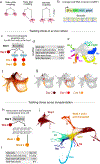Lineage tracing on transcriptional landscapes links state to fate during differentiation
- PMID: 31974159
- PMCID: PMC7608074
- DOI: 10.1126/science.aaw3381
Lineage tracing on transcriptional landscapes links state to fate during differentiation
Abstract
A challenge in biology is to associate molecular differences among progenitor cells with their capacity to generate mature cell types. Here, we used expressed DNA barcodes to clonally trace transcriptomes over time and applied this to study fate determination in hematopoiesis. We identified states of primed fate potential and located them on a continuous transcriptional landscape. We identified two routes of monocyte differentiation that leave an imprint on mature cells. Analysis of sister cells also revealed cells to have intrinsic fate biases not detectable by single-cell RNA sequencing. Finally, we benchmarked computational methods of dynamic inference from single-cell snapshots, showing that fate choice occurs earlier than is detected by state-of the-art algorithms and that cells progress steadily through pseudotime with precise and consistent dynamics.
Copyright © 2020 The Authors, some rights reserved; exclusive licensee American Association for the Advancement of Science. No claim to original U.S. Government Works.
Figures





Comment in
-
Transcriptomics of developmental fate.Nat Rev Genet. 2020 Apr;21(4):203. doi: 10.1038/s41576-020-0221-4. Nat Rev Genet. 2020. PMID: 32086496 No abstract available.
-
Integrating lineage tracing and single-cell analysis.Nat Methods. 2020 Apr;17(4):359. doi: 10.1038/s41592-020-0802-3. Nat Methods. 2020. PMID: 32242155 No abstract available.
-
Hematopoiesis in High Definition: Combining State and Fate Mapping.Cell Stem Cell. 2020 Sep 3;27(3):354-355. doi: 10.1016/j.stem.2020.08.010. Cell Stem Cell. 2020. PMID: 32888423
References
Publication types
MeSH terms
Grants and funding
LinkOut - more resources
Full Text Sources
Other Literature Sources
Molecular Biology Databases
Research Materials

